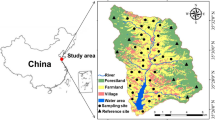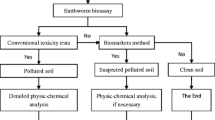Abstract
To explore the main controlling factors in soil and build a predictive model between the lead concentrations in earthworms (Pbearthworm) and the soil physicochemical parameters, 13 soils with low level of lead contamination were used to conduct toxicity experiments using earthworms. The results indicated that a relatively high bioaccumulation factor appeared in the soils with low pH values. The lead concentrations between earthworms and soils after log transformation had a significantly positive correlation (R2 = 0.46, P < 0.0001, n = 39). Stepwise multiple linear regression analysis derived a fitting empirical model between Pbearthworm and the soil physicochemical properties: log(Pbearthworm) = 0.96log(Pbsoil) − 0.74log(OC) − 0.22pH + 0.95, (R2 = 0.66, n = 39). Furthermore, path analysis confirmed that the Pb concentrations in the soil (Pbsoil), soil pH, and soil organic carbon (OC) were the primary controlling factors of Pbearthworm with high pathway parameters (0.71, − 0.51, and − 0.49, respectively). The predictive model based on Pbearthworm in a nationwide range of soils with low-level lead contamination could provide a reference for the establishment of safety thresholds in Pb-contaminated soils from the perspective of soil-animal systems.




Similar content being viewed by others
References
Adriano DC (2001) Trace elements in terrestrial environments. Q Rev Biol 32:374
Ardestani MM, van Straalen NM, van Gestel CA (2014) Uptake and elimination kinetics of metals in soil invertebrates: a review. Environ Pollut 193:277–295
Beintema A, Thissen J, Tensen D, Visser G (1991) Feeding ecology of charadriiform chicks in agricultural grassland. Ardea 71:31–43
Benckiser G (1997) Fauna in soil ecosystems: recycling processes, nutrient fluxes, and agricultural production. Marcel Dekker Inc., New York
Bengtsson G, Nordström S, Rundgren S (1983) Population density and tissue metal concentration of lumbricids in forest soils near a brass mill. Environ Pollut 30:87–108
Bisessar S (1982) Effect of heavy metals on microorganisms in soils near a secondary lead smelter. Water Air Soil Pollut 17:305–308
Bosveld A, Klok T, Bodt J, Rutgers M (2000) Ecologische risico’s van bodemverontreinigingen in toemaakdek in de gemeente De Ronde Venen, Alterra, Research Instituut voor de Groene Ruimte. Alterrarapport 151
Bradham KD, Dayton EA, Basta NT, Schroder J, Payton M, Lanno RP (2006) Effect of soil properties on lead bioavailability and toxicity to earthworms. Environ Toxicol Chem 25:769–775
Chlopecka A, Bacon J, Wilson M, Kay J (1996) Forms of cadmium, lead, and zinc in contaminated soils from Southwest Poland. J Environ Qual 25:69–79
Corp N, Morgan A (1991) Accumulation of heavy metals from polluted soils by the earthworm, Lumbricus rubellus: can laboratory exposure of ‘control’worms reduce biomonitoring problems? Environ Pollut 74:39–52
De Haan S, Rethfeld H, Van Driel W (1985) Acceptable levels of heavy metals (Cd, Cr, Cu, Ni, Pb, Zn) in soils, depending on their clay and humus content and cation-exchange capacity, Research report
Ding C, Li X, Zhang T, Wang X (2015) Transfer model of lead in soil–carrot (Daucus carota L.) system and food safety thresholds in soil. Environ Toxicol Chem 34:2078–2086
Edwards CA (1998) Earthworm ecology. CRC Press, Boca Raton
Finkelstein Y, Markowitz ME, Rosen JF (1998) Low-level lead-induced neurotoxicity in children: an update on central nervous system effects. Brain Res Rev 27:168–176
Gaw SK, Kim ND, Northcott G, Wilkins AL, Robinson G (2008) Uptake of ΣDDT, arsenic, cadmium, copper, and lead by lettuce and radish grown in contaminated horticultural soils. J Agric Food Chem 56:6584–6593
Hågvar S, Abrahamsen G (1990) Microarthropoda and Enchytraeidae (Oligochaeta) in naturally lead-contaminated soil: a gradient study. Environ Entomol 19:1263–1277
Hirano T, Tamae K (2011) Earthworms and soil pollutants. Sensors 11:11157–11167
Kabala C, Singh BR (2001) Fractionation and mobility of copper, lead, and zinc in soil profiles in the vicinity of a copper smelter. J Environ Qual 30:485–492
Kabata-Pendias A (2010) Trace elements in soils and plants. CRC press, Boca Raton
Klok C, van der Hout A, Bodt J (2006) Population growth and development of the earthworm Lumbricus rubellus in a polluted field soil: possible consequences for the godwit (Limosa limosa). Environ Toxicol Chem 25:213–219
Lee KE (1985) Earthworms: their ecology and relationships with soils and land use. Environ Pollut 42:94–94
Leyval C, Turnau K, Haselwandter K (1997) Effect of heavy metal pollution on mycorrhizal colonization and function: physiological, ecological and applied aspects. Mycorrhiza 7:139–153
Lidsky TI, Schneider JS (2003) Lead neurotoxicity in children: basic mechanisms and clinical correlates. Brain 126:5–19
Ma W, Edelman T, Van Beersum I, Jans T (1983) Uptake of cadmium, zinc, lead, and copper by earthworms near a zinc-smelting complex: influence of soil pH and organic matter. Bull Environ Contam Toxicol 30:424–427
Ministry of Environmental Protection and Land and Resources People’s Republic of China (2014) Bulletin National Survey of Soil Pollution (In Chinese), Research report
Morgan A, Morgan J, Turner M, Winters C, Yarwood A (1993) Ecotoxicology of metals in invertebrates. Freshw Sci 13:326
Nannoni F, Protano G, Riccobono F (2011) Fractionation and geochemical mobility of heavy elements in soils of a mining area in northern Kosovo. Geoderma 161:63–73
OECD (1984) Guidelines for the testing of chemicals no.207 earthworm. Acute toxicity tests. OECD Publishing, Paris
Peijnenburg WJ, Baerselman R, de Groot AC, Jager T, Posthuma L, Van Veen RP (1999) Relating environmental availability to bioavailability: soil-type-dependent metal accumulation in the oligochaete Eisenia andrei. Ecotoxicol Environ Saf 44:294–310
Prat P, Charrier M, Deleporte S, Frenot Y (2002) Digestive carbohydrases in two epigeic earthworm species of the Kerguelen Islands (Subantarctic). Pedobiologia 46:417–427
Sanderson P, Naidu R, Bolan N, Bowman M (2011) Critical review on chemical stabilization of metal contaminants in shooting range soils. J Hazard Toxic Radioa Waste 16:258–272
Sauvé S, Hendershot W, Allen HE (2000) Solid-solution partitioning of metals in contaminated soils: dependence on pH, total metal burden, and organic matter. Environ Sci Technol 34:1125–1131
Smolders E, Oorts K, Van Sprang P, Schoeters I, Janssen CR, McGrath SP, McLaughlin MJ (2009) Toxicity of trace metals in soil as affected by soil type and aging after contamination: using calibrated bioavailability models to set ecological soil standards. Environ Toxicol Chem 28:1633–1642
Strawn DG, Sparks DL (2000) Effects of soil organic matter on the kinetics and mechanisms of Pb (II) sorption and desorption in soil. Soil Sci Soc Am J 64:144–156
Tang R, Ding C, Ma Y, Wang J, Zhang T, Wang X (2017a) Time-dependent responses of earthworms to soil contaminated with low levels of lead as detected using 1 H NMR metabolomics. RSC Adv 7:34170–34181
Tang R, Ding C, Ma Y, Wang J, Zhang T, Wang X (2017b) Metabolic responses of Eisenia fetida to individual Pb and Cd contamination in two types of soils. Sci Rep 7:13110
Tyler G, Påhlsson A-MB, Bengtsson G, Bååth E, Tranvik L (1989) Heavy-metal ecology of terrestrial plants, microorganisms and invertebrates. Water Air Soil Pollut 47:189–215
Wilke B (1990) Effects of different abiotic soil properties on the microbial toxicity of zinc. Agribiol Res 43:309–318
Woolf AD, Goldman R, Bellinger DC (2007) Update on the clinical management of childhood lead poisoning. Pediatr Clin N Am 54:271–294
Xia J (1996) Detailed annotation of environmental quality standard for soils (In Chinese). Environmental Science Press, Beijing
Xiong Y, Li Q (1987) Chinese soils. Science Press, Beijing (In Chinese)
Zhang X, Lin F, Wong MT, Feng X, Wang K (2009) Identification of soil heavy metal sources from anthropogenic activities and pollution assessment of Fuyang County, China. Environ Monit Assess 154:439–449
Zhao F, Ma Y, Zhu Y, Tang Z, McGrath SP (2014) Soil contamination in China: current status and mitigation strategies. Environ Sci Technol 49:750–759
Zhu Y, Sun G, Lei M, Teng M, Liu Y, Chen N, Wang L, Carey A, Deacon C, Raab A (2008) High percentage inorganic arsenic content of mining impacted and nonimpacted Chinese rice. Environ Sci Technol 42:5008–5013
Funding
This research was supported by the National Key Research and Development Plan of China (2016YFD0800407) and the National Natural Science Foundation of China (41501347).
Author information
Authors and Affiliations
Corresponding author
Ethics declarations
Conflict of interest
The authors declare that they have no conflicts of interest.
Additional information
Responsible editor: Zhihong Xu
Electronic supplementary material
ESM 1
(DOCX 217 kb)
Rights and permissions
About this article
Cite this article
Tang, R., Ding, C., Ma, Y. et al. Main controlling factors and forecasting models of lead accumulation in earthworms based on low-level lead-contaminated soils. Environ Sci Pollut Res 25, 23117–23124 (2018). https://doi.org/10.1007/s11356-018-2436-x
Received:
Accepted:
Published:
Issue Date:
DOI: https://doi.org/10.1007/s11356-018-2436-x




